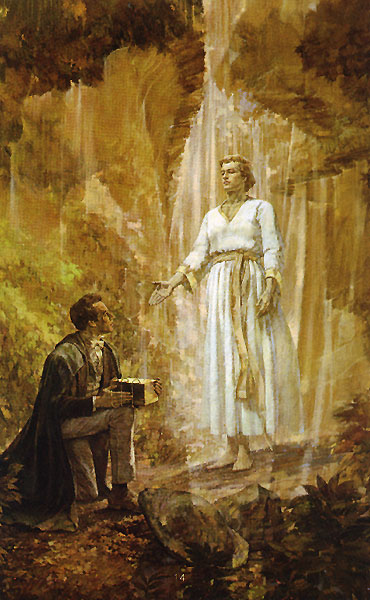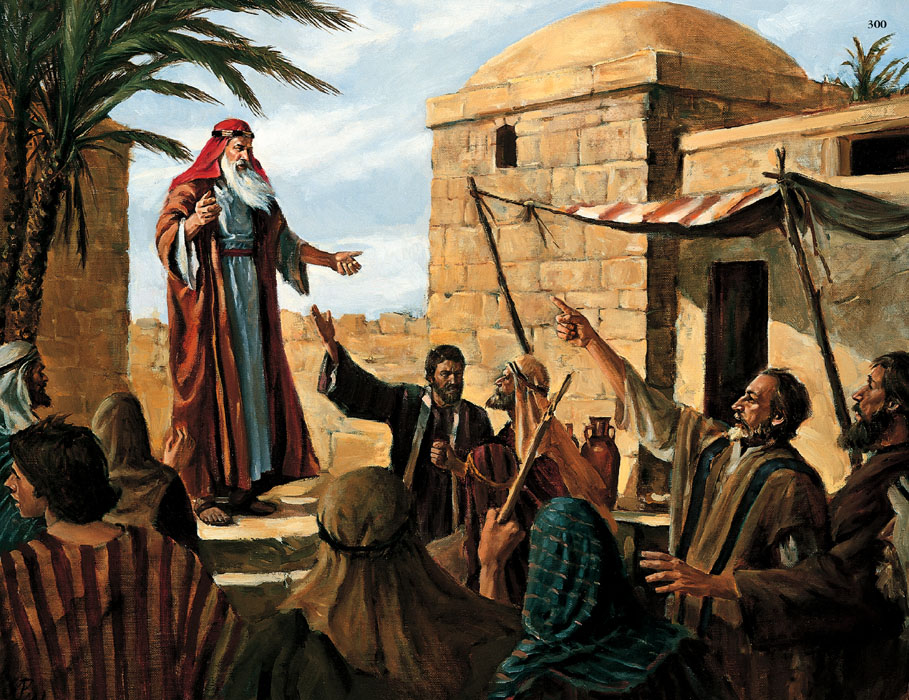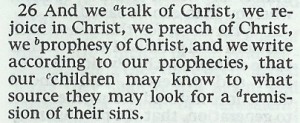 The Book of Mormon is a record of a people that lived in the Americas between 600BC and 400AD as well as their origins, lives and religion. The record, written on gold plates, was given to Joseph Smith and he was given the ability to translate it from the original language, reformed Egyptian.
The Book of Mormon is a record of a people that lived in the Americas between 600BC and 400AD as well as their origins, lives and religion. The record, written on gold plates, was given to Joseph Smith and he was given the ability to translate it from the original language, reformed Egyptian.
The Book of Mormon starts with a title page and introduction to familiarize the reader with the book’s purpose and history. As the title page states, the Book of Mormon was written as a witness and testament that Jesus is the Christ, the Eternal God and that He manifests Himself unto all nations. The final paragraphs of the introduction contains an invitation to read the book and a promise that if one will read it, ponder over the words, and pray to God, asking if the book is true, then an answer will be given by the power of the Holy Ghost. After this invitation, the testimonies of the eight witnesses, the three witnesses and Joseph Smith are given.
The book then begins. Its format is similar to the Bible, in that there are individual books within the greater book and these are divided into chapters and verses. The first book was written by a man named Nephi living in Jerusalem around 600BC and is taken from a record mentioned in the book called the Small Plates of Nephi. The small plates were like a journal that Nephi kept and was passed on in the family for generations. In it, he and others recorded prophecies, teachings and “a few of the things which [they] considered to be most precious.” (Jacob 1:2) Nephi made other plates, the large plates, on which he wrote the daily goings-on of his people. That book was passed down from king to king and was eventually abridged by a prophet named Mormon. That abridgment comprises most of the Book of Mormon. The first part, however, is taken directly from the small plates.
 Nephi tells the story of his father, Lehi, and his vision. Much the same way that Isaiah, Jeremiah and Ezekiel were called to be prophets, Lehi sees a vision of God, learns of His gospel and is sent among the people to warn them of their wickedness and the impeding doom of the city. Predictably, he is rejected by the people and threats are made on his life (Jeremiah is probably in prison at this time) so the Lord commands him to take his family and absquatulate into the desert. Nephi records their experiences, trials and the things they learn about Christ and His gospel as they travel eight years through the desert from Jerusalem to an unknown point on the Arabian coast where they build a boat, according the Lord’s directions, and cross the ocean to the promised land.
Nephi tells the story of his father, Lehi, and his vision. Much the same way that Isaiah, Jeremiah and Ezekiel were called to be prophets, Lehi sees a vision of God, learns of His gospel and is sent among the people to warn them of their wickedness and the impeding doom of the city. Predictably, he is rejected by the people and threats are made on his life (Jeremiah is probably in prison at this time) so the Lord commands him to take his family and absquatulate into the desert. Nephi records their experiences, trials and the things they learn about Christ and His gospel as they travel eight years through the desert from Jerusalem to an unknown point on the Arabian coast where they build a boat, according the Lord’s directions, and cross the ocean to the promised land.
 Some time after arriving, Lehi gives his dying words to his children and grandchildren and passes away. It didn’t take long for Nephi’s oldest brothers, Laman and Lemuel, to try and kill Nephi. They had been complaining, rebelling and plotting Nephi’s death since they left Jerusalem because they did not believe that Lehi had a vision nor did they believe in God all that much. Nephi took his wife, kids and anyone else who would listen away from Laman’s group so they could live peacefully and worship God. From that time until the very end of the book, the two main groups are referred to as Nephites and Lamanites.
Some time after arriving, Lehi gives his dying words to his children and grandchildren and passes away. It didn’t take long for Nephi’s oldest brothers, Laman and Lemuel, to try and kill Nephi. They had been complaining, rebelling and plotting Nephi’s death since they left Jerusalem because they did not believe that Lehi had a vision nor did they believe in God all that much. Nephi took his wife, kids and anyone else who would listen away from Laman’s group so they could live peacefully and worship God. From that time until the very end of the book, the two main groups are referred to as Nephites and Lamanites.
Nephi spends the rest of his book writing down a few of his thoughts and feelings, but mostly prophecies and teachings and many words of the prophet Isaiah. Nephi then passes the metal plates he used to write on, to his brother Jacob and dies. Jacob continues to write and records a few of his sermons to the people and passes them to his son, Enos. The tradition continues for several generations, each of them writing a little until one man, who had no children, passes the plates on to the king, a righteous man named Benjamin. By this time, over 450 years had passed since Lehi and his family had left Jerusalem.
During the time that this record was kept, the Nephites and Lamanites fought against each other and had several wars. At one point, the Nephite king, Mosiah, was warned by the Lord to leave their lands and go north. He took as many people with him as would listen and left their city to find a new place to live. Mosiah was led by the Lord and found an entire city of people called Zarahemla. Their history is largely unknown except that they were originally led by Mulek out of Jerusalem when Babylon invaded Jerusalem in 585 BC. The two groups merged and Mosiah, followed by his son Benjamin, became their king. This marks the end of the small plates.
 The most remarkable thing about these writings is how much Nephi and his descendants knew about the coming Messiah. Nephi was shown the birth of Jesus in a vision and understood the miraculous power of the atonement. He writes, “And we talk of Christ, we rejoice in Christ, we preach of Christ, we prophesy of Christ, and we write according to our prophecies, that our children may know to what source they may look for a remission of their sins” (2 Nephi 2:26). We share this book with you, and with the whole world for the same purpose. Please take the opportunity to read it for yourself.
The most remarkable thing about these writings is how much Nephi and his descendants knew about the coming Messiah. Nephi was shown the birth of Jesus in a vision and understood the miraculous power of the atonement. He writes, “And we talk of Christ, we rejoice in Christ, we preach of Christ, we prophesy of Christ, and we write according to our prophecies, that our children may know to what source they may look for a remission of their sins” (2 Nephi 2:26). We share this book with you, and with the whole world for the same purpose. Please take the opportunity to read it for yourself.